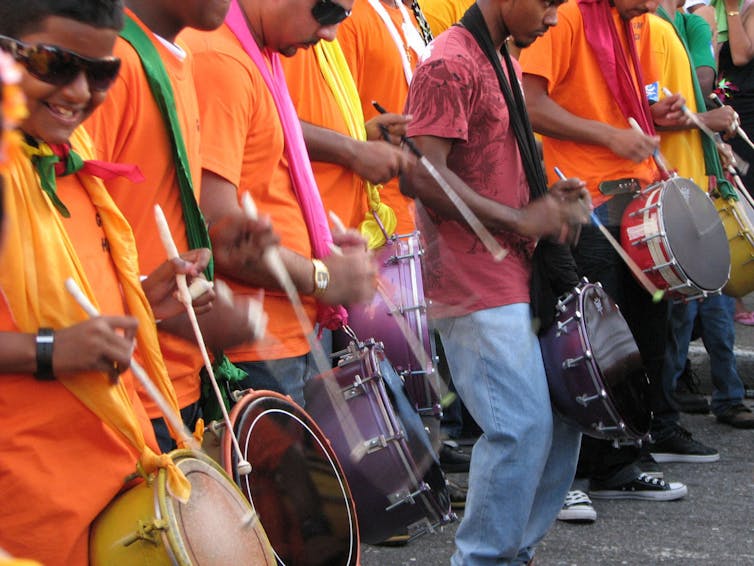by KEN CHITWOOD
 Trinidad’s Hosay brings in a more carnival-like joy to a somber remembrance. PHOTO/Nicholas Laughlin/CC BY-NC-SA
Trinidad’s Hosay brings in a more carnival-like joy to a somber remembrance. PHOTO/Nicholas Laughlin/CC BY-NC-SA
A throng of Trinidadians line up along the streets of St. James and Cedros to admire the vibrant floats with beautifully bedecked models of mausoleums. Their destination is the waters of the Caribbean, where the crowds will push them out to float.
This is part of the Hosay commemorations, a religious ritual performed by Trinidadian Muslims, that I have observed as part of the research for my forthcoming book on Islam in Latin America and the Caribbean.
What fascinates me is how a practice from India has been transformed into something uniquely Caribbean.
Re-enacting tragedy
During the 10 days of the Islamic month of Muharram, Shiite Muslims around the world remember the martyrdom of Hussein, Prophet Muhammad’s grandson, who was killed in a battle in Karbala, today’s Iraq, some 1,338 years ago. For Shiite Muslims Hussein is the rightful successor to Prophet Muhammad.
Ashura, the 10th day of Muharram, is marked by public mourning and a re-enactment of the tragedy. Shiite Muslims put on passion plays that include inflicting suffering, as a way to remember Hussein. In Iraq, Shiite are known to beat themselves with swords. In India, mourners whip themselves with sharp blades. Some Shiite also visit Hussein’s shrine in Iraq.
The commemoration has also become a symbol for the broader Shiite struggle for justice as a minority in the global Muslim community.
Early history
In Trinidad, the 100,000 Muslims who make up 5 percent of the island’s total population, celebrate the day of Ashura, as Hosay – the name derived from “Hussein.”
The first Hosay festival was held in 1854, just over a decade after the first Indian Muslims began to arrive from India to work on the island’s sugar plantations.
But Trinidad at the time was under British colonial rule and large public gatherings were not permitted. In 1884, the British authorities issued a prohibition against Hosay commemorations. Approximately 30,000 people took to the streets, in Mon Repos, in the south, to protest against the ordinance. Shots fired to disperse the crowd killed 22 and injured over 100. The ordinance was later overturned.
The “Hosay Massacre” or “Muharram Massacre,” however, lives in people’s memories.
Colorful floats of Trinidad
These days, Hosay celebrations in St. James and Cedros not only recall Hussein, but also those killed during the 1884 Hosay riots. Rather than recreate the events through self-flagellation or other forms of suffering, however, people in Trinidad create bright and beautiful floats, called “tadjahs,” that parade through the streets to the sea.
…
A bit carnival, a bit Ashura
While the festival is certainly a somber one in terms of its tribute, it is also a joyous occasion where families celebrate with loud music and don festive attire. This has led some to compare Hosay to Trinidad’s world-famous carnival with its accompanying “joie de vivre.”
The Conversation for more
